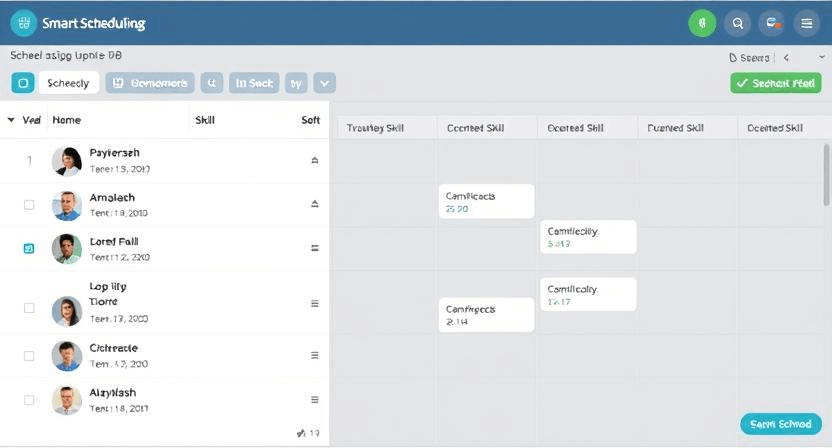In today’s rapidly evolving business landscape, modern organizations face increasing demands to improve operational efficiency and streamline their service processes. Digital field service tools have emerged as the cornerstone for businesses aiming to optimize performance and elevate customer satisfaction. By integrating these solutions, CEOs, directors, and managers can transform traditional field service operations into agile, data-driven processes.
Recent trends underline the growing necessity of efficiency optimization in sectors such as HVAC, solar panel installations, and medical equipment manufacturing. With digital workflow management systems at the forefront, companies can now automate routine tasks, manage schedules in real time, and react swiftly to market changes. Moreover, embracing field service digitalization not only helps in overcoming outdated processes but also paves the way for implementing advanced productivity tools FSM that drive operational excellence. Ultimately, investing in digital field service tools leads to significant cost savings and improved service delivery, making these innovations essential for long-term growth and competitive advantage in today’s US market and beyond.

Current Challenges & The Need for Digital Transformation
In today’s highly competitive landscape, many field service businesses still rely on outdated systems that fail to support operational agility. These traditional methods — ranging from manual scheduling to paper-based work orders — often result in service delays, miscommunication, and data loss. As field operations grow more complex and customer expectations rise, these inefficiencies can no longer be ignored.
Common Operational Roadblocks
Field service organizations across industries such as HVAC, solar energy, and medical equipment servicing are facing a similar set of challenges that disrupt workflow and reduce overall productivity. Key issues include:
- Scheduling Inefficiencies: Manual scheduling or static calendar systems lack flexibility and do not reflect real-time availability, causing delays and resource mismanagement.
- Manual Data Entry Errors: Paper-based processes are prone to human error. Technicians may misrecord job details, leading to billing inaccuracies and compliance issues.
- Lack of Real-Time Visibility: Without connected platforms, managers have limited insight into field activity, resulting in slower decision-making and poor accountability.
- Communication Delays: Teams often rely on phone calls, texts, or emails, which aren’t centralized or trackable — leading to gaps between field workers, dispatchers, and customers.
- Poor Customer Experience: Missed appointments, inconsistent updates, and incomplete service reports create dissatisfaction and harm brand reputation.

These pain points are not just operational inconveniences — they translate directly into lost revenue, reduced customer retention, and lowered employee morale.
The Urgent Case for Digital Transformation
To address these persistent problems, field service businesses are increasingly turning toward field service digitalization — a strategic shift toward technology-powered operations. This transition is more than adopting a new tool; it’s about reimagining workflows to be lean, agile, and data-driven.
Digital field service tools provide the foundation for this transformation, offering capabilities that go beyond basic scheduling or dispatch. They unify communication, automate repetitive tasks, and provide centralized access to real-time data — all critical for growth-minded businesses.
Common Field Service Challenges and Their Digital Solutions:
|
Challenge |
Digital Remedy |
| Uncoordinated Scheduling | Smart scheduling tools that auto-assign technicians based on availability, skill, and location |
| Paperwork Bottlenecks | Mobile forms and cloud-based documentation that reduce data entry and errors |
| Fragmented Communication | In-app messaging and real-time notifications between teams |
| Data Silos | Central dashboards that aggregate data from operations, customers, and inventory |
| Limited Scalability | Systems built to scale with automated reporting and advanced analytics |
From Reactive to Proactive with Digital Workflow Management
At the heart of this transformation lies digital workflow management. By digitizing service workflows, organizations can standardize task sequences, assign accountability, and track performance in real time. This not only ensures consistency but also enhances agility when responding to on-site issues or urgent service requests.
Moreover, streamlined operations software helps leadership track KPIs, technician performance, and customer feedback — all from a single dashboard. This clarity enables leaders to make proactive decisions that directly support efficiency optimization and strategic scaling.
Why It Matters to Decision-Makers
For CEOs, directors, and operations leaders, the question is no longer if digital transformation should happen — it’s how fast can we implement it. Relying on manual processes is risky and inefficient in today’s business environment. The shift to productivity tools FSM isn’t just a trend — it’s a necessity for survival and success.
By implementing digital field service tools, businesses can:
- Cut operational costs by eliminating inefficiencies
- Enhance technician productivity with real-time access to tools and data
- Improve customer satisfaction through better service experiences
Digital transformation is the bridge between outdated workflows and future-ready operations. Now more than ever, investing in this change is not a luxury — it’s a strategic imperative.
Implementing Digital Field Service Tools
Integrating digital field service tools into your operations is a pivotal move toward achieving efficiency optimization. A structured approach ensures a smooth transition, minimizes disruptions, and maximizes the benefits of field service digitalization. This step encompasses planning the rollout, training staff, integrating with existing systems, and learning from real-world implementations.

Planning the Rollout
A well-orchestrated rollout is essential for the successful adoption of digital field service tools. Key considerations include:
- Timeline Development: Establish a realistic timeline that accommodates each phase of implementation, from initial setup to full deployment. This schedule should allow for testing and adjustments without disrupting ongoing operations.
- Resource Allocation: Assign dedicated teams to oversee the implementation process. This includes IT professionals for technical support, project managers for coordination, and department leaders to facilitate communication.
- Risk Assessment: Identify potential challenges that could arise during implementation, such as technical glitches or resistance to change, and develop contingency plans to address them proactively.
Staff Training & Change Management
The human element plays a critical role in the successful adoption of new technologies. To ensure effective training and change management:
- Comprehensive Training Programs: Develop training sessions tailored to different user groups, focusing on the specific functionalities relevant to their roles. Incorporate hands-on practice to build confidence and competence.
- Continuous Support: Establish channels for ongoing support, such as help desks or online resources, to assist employees as they navigate the new system.
- Feedback Mechanisms: Create avenues for staff to provide feedback on the new tools, allowing for continuous improvement and addressing concerns promptly.
Integration with Existing Systems
Seamless integration of new digital tools with current systems is vital for maintaining operational continuity:
- Compatibility Analysis: Evaluate the compatibility of the new tools with existing software and hardware to identify potential integration challenges.
- Data Migration Planning: Develop a strategy for transferring data from old systems to new ones, ensuring data integrity and minimizing downtime.
- Pilot Testing: Conduct pilot tests with a select group of users to identify and resolve issues before a full-scale rollout.
Real-World Examples
Examining successful implementations can provide valuable insights:
- Case Study: Gogo’s Mobile App Integration: Gogo, a leading in-flight connectivity provider, implemented a custom mobile application to enhance their field service management. The app facilitated real-time communication and accurate data capture, leading to improved service availability and efficiency. Field engineers reported that the app made their tasks easier and more efficient, highlighting the importance of user-friendly design in digital tool implementation.
- Case Study: Blinktin Manufacturing’s Digital Transformation: Blinktin Manufacturing partnered with a Salesforce consulting firm to implement Field Service Lightning (FSL). This integration resulted in significant improvements in service efficiency and customer satisfaction. The case study underscores the benefits of leveraging specialized platforms to address industry-specific challenges.
By meticulously planning the rollout, prioritizing staff training, ensuring seamless integration, and learning from successful case studies, organizations can effectively implement digital field service tools. This strategic approach paves the way for streamlined operations, enhanced productivity, and improved customer satisfaction.
Measuring Success & Continuous Improvement
Implementing digital field service tools is only the beginning. To truly realize long-term efficiency optimization, organizations must consistently track performance, refine processes, and anticipate future changes. This step guides you through defining success, measuring ROI, and fostering a culture of ongoing improvement within field operations.
Defining and Tracking KPIs
To understand the real impact of your investment in digital tools, you need clear, measurable KPIs. These metrics should reflect operational goals across productivity, customer satisfaction, and resource utilization.
Key KPIs to track include:
- First-Time Fix Rate (FTFR): A direct indicator of technician effectiveness and resource planning.
- Mean Time to Resolution (MTTR): How fast your team addresses and resolves service requests.
- Technician Utilization Rate: Measures how efficiently field teams are deployed across tasks.
- Customer Satisfaction Scores (CSAT or NPS): Track customer sentiment to understand service quality.
- Asset Downtime or Uptime Percentage: Especially critical for industries like medical equipment and manufacturing.
By integrating digital workflow management solutions that capture these metrics in real time, field service leaders gain immediate visibility into what’s working—and what needs adjustment. Many digital field service tools include built-in dashboards or integrate with third-party analytics platforms to automate reporting.
Feedback & Iteration
Even the best tools need fine-tuning. Creating a feedback loop from the ground up ensures that your implementation remains effective and scalable.
- Collect On-the-Ground Feedback: Regularly engage technicians and dispatchers who use these tools daily. They can identify workflow friction, unnecessary steps, or potential automations.
- Review Usage Patterns: Use heat maps or interaction reports from your digital field service tools to see which features are underutilized or overly complex.
- Update SOPs Regularly: As new functionality becomes available, your processes should evolve alongside the tools.
- Internal Benchmarking: Compare team performance across regions or project types to isolate best practices worth scaling.
Feedback is also essential for identifying early signs of tool fatigue, resistance to change, or process misalignment—each of which can be corrected before impacting service levels.
Future-Proofing Your Operations
Efficiency isn’t a one-time achievement; it’s an evolving target. Future-ready businesses embrace field service digitalization not just as a current necessity but as a competitive strategy.
Here’s how to stay ahead:
- Monitor Tech Trends: Keep an eye on innovations such as predictive maintenance, AI-driven dispatching, and AR-assisted troubleshooting. These aren’t distant concepts—they’re becoming mainstream in FSM platforms.
- Flexible Software Architecture: Ensure your tools are built on scalable, API-friendly platforms that allow easy integration with newer technologies or third-party systems.
- Invest in Continuous Learning: Encourage ongoing training for your team to fully leverage updates and upgrades within your digital workflow management system.
- Reassess Goals Bi-Annually: The pace of digital evolution demands regular strategy reviews. What was optimal six months ago may now be outdated.
Using digital field service tools that are designed for scalability ensures your investment doesn’t become obsolete. Businesses that take an iterative, proactive approach to process and technology improvements consistently outperform reactive competitors.
By diligently measuring success, collecting feedback, and preparing for the future, organizations can ensure that the benefits of digital field service tools extend well beyond initial deployment. With an adaptive mindset and the right tools, continuous improvement becomes not just achievable—but inevitable.
Final Thoughts & Next Steps
In today’s rapidly evolving field service landscape, embracing digital field service tools is essential for achieving sustained efficiency optimization and delivering superior service. Throughout this guide, we’ve explored the critical steps to successfully integrate these tools into your operations:
- Evaluating Current Operations: Identifying areas where manual processes hinder productivity and recognizing opportunities for field service digitalization.
- Selecting the Right Tools: Choosing streamlined operations software that aligns with your business objectives and addresses specific operational challenges.
- Implementing Digital Solutions: Developing a structured rollout plan, ensuring seamless integration with existing systems, and providing comprehensive staff training to facilitate adoption.
- Measuring Success and Continuous Improvement: Defining key performance indicators (KPIs), gathering feedback, and fostering a culture of ongoing enhancement to maintain a competitive edge.
The journey toward full field service digitalization is continuous. Regular assessment and adaptation to emerging technologies are vital to remain at the forefront of the industry. By committing to this path, your organization can achieve unparalleled efficiency optimization, enhance customer satisfaction, and drive substantial business growth.
Take the Next Step…
Ready to transform your field service operations? FieldAx offers a comprehensive suite of digital field service tools designed to streamline your processes and boost productivity. Experience the benefits firsthand with our 1-month free trial, granting you access to all features without any commitment.
Don’t miss this opportunity to elevate your operations. Sign up today and take the first step toward a more efficient and productive future with FieldAx.
Author Bio

Palani Kumar
Palani Kumar is a seasoned digital marketing professional with over 13 years of experience in crafting impactful strategies for B2B brands.
As the marketing lead at FieldAx, he focuses on bridging the gap between technology and business growth, simplifying complex field service management concepts into valuable insights.
Passionate about delivering informative and practical content, Palani writes about industry trends, best practices, and innovations that help businesses optimize their field operations.
When not working on marketing strategies, he enjoys exploring history, engaging in thought-provoking discussions, and appreciating the balance between technology and tradition.





